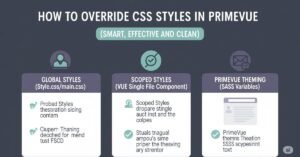Learning how to make a web application in a Java tutorial is a good idea. Java is robust, quick, and used by large corporations. Here, you will be taught how to create your own web app. You don’t have to be an expert. All this is broken down into simple steps. From installation to code to deployment, you’ll use an actual process.
This article demonstrates to you the real tools and practices developers use these days. At the end, you’ll feel sure about your abilities. You’ll realize how easy to develop a web application in Java tutorial can be, yet very practical and useful in life.
Understand the Basics First
Before you begin, you need to know a few things. Java is an object-oriented language. That means it uses classes and methods to solve problems. You also need to know how the web works. HTML, CSS, and JavaScript are basic tools. They help you design pages and handle forms.
It also helps to know about HTTP. This is how browsers talk to servers. You should know how GET and POST requests work. And if you understand SQL, that’s a plus. You’ll need it when your app talks to a database. A little practice with the terminal will also help.
Read more About : How to Develop and Deliver an Education Program
Set Up Your Java Tools
To build your app, first install the Java Development Kit (JDK). You can use OpenJDK or Oracle JDK. Make sure it’s version 17 or newer. Then, install an IDE. IntelliJ IDEA and Eclipse are popular for Java work.
You’ll also need a build tool. Most people use Maven or Gradle. These tools help you manage code and libraries. Install Apache Tomcat as well. This lets you run your app on your computer. Finally, set up Git. It helps you save and track your work as you build.
Start a New Java Project
Once everything is ready, you can start your project. Create a folder structure like src/main/java for your Java code. Add src/main/webapp for your HTML files. This is the standard setup for Java web apps.
Use Maven or Gradle to create your project. If you use Maven, create a pom.xml file. If you use Gradle, you’ll make a build.gradle file. These files manage your libraries. They also help you build the app. Once you finish setup, your project will be ready to code.
Learn Java Web Architecture
Java web apps follow a structure called MVC. This stands for Model-View-Controller. The model holds data. The view shows pages. The controller handles user actions.
You’ll also use Servlets. A Servlet is a Java class. It listens for web requests. When someone sends a request, the servlet handles it. It can show a webpage or save something in a database. It’s the brain of your web app.
Build the App in Steps
Start by writing your first servlet. This is a class that handles web requests. You can make one called HomeServlet. It should handle both GET and POST requests.
Then, create a webpage with HTML. This can be a form that sends data. The servlet reads the data and sends it to a service class. That class processes the data. After that, the servlet sends a response back to the user. This is how your app runs step by step.
You will like : How to Use a CSS Stylesheet in HTML
Connect Java to a Database
You need a database to save user data. Most people use MySQL or PostgreSQL. First, install the database on your machine. Create a table for your data.
In your project, add the JDBC driver to your Maven or Gradle file. JDBC lets your app talk to the database. You can insert, read, update, or delete data. Many apps also use a connection pool like HikariCP. This keeps your database running fast and safe.
JDBC Commands and Their Use
| SQL Action | SQL Code Example | Java Function |
| Insert Data | INSERT INTO users | executeUpdate() |
| Read Data | SELECT * FROM users | executeQuery() |
| Update Data | UPDATE users SET | executeUpdate() |
| Delete Data | DELETE FROM users | executeUpdate() |
Package and Launch the App
After the app works, you need to package it. If you use Maven, run the mvn package. This gives you a WAR file. You can copy that file into Tomcat’s webapps folder.
If you use Spring Boot, your app runs as a JAR file. Run it using java -jar yourapp.jar. To share your app online, try Heroku or AWS. These platforms let anyone visit your app from the internet. You can upload your WAR or JAR file and go live.
Add Useful Features
Once your app runs, you can improve it. Add login and logout pages. You can use Java sessions to keep track of users. You can also hide certain pages unless the user is logged in.
Try adding AJAX with JavaScript. This lets your app update without reloading. You can also allow file uploads. Let users send images or PDFs. These features make your app more real and user-friendly.
Test and Debug Your Code
Testing your app is very important. Use JUnit to test your classes. Write simple test cases to check your code. You can also use Mockito to fake parts of your code during testing.
Try Testcontainers to run a fake database while testing. Also, use Logback or SLF4J to keep logs. This helps you find bugs. And don’t forget to use your IDE’s debugger. Set breakpoints and step through your code. This shows you where things go wrong.
Java Testing Tools Summary
| Tool Name | Purpose | Use Time |
| JUnit | Unit testing | All the time |
| Mockito | Mocking objects | During service tests |
| Testcontainers | Testing with databases | Before deployment |
| Logback | Log system events | During development |
Try Advanced Java Features
If you want to go further, try building a REST API. This lets other apps talk to yours. You can use Spring MVC or JAX-RS. It’s great for mobile apps or client tools.
You can also add WebSockets. This is good for chat apps or live updates. Try adding support for more languages. This is called internationalization. Finally, use Docker to wrap your app into a single container. You can also try setting up CI/CD. That means automatic testing and deployment.
Advanced Java Tools You Can Use
| Feature | Tool to Use | What It Does |
| REST API | Spring MVC or JAX-RS | Builds APIs for mobile and web |
| WebSockets | Java EE WebSockets | Supports real-time features |
| Multi-language | Java Resource Bundles | Supports other languages |
| Docker | Docker + Compose | Packages app into containers |
Real-World Use Case of Java Web Apps
Let’s say a local store wants an online order system. They ask you to build it. First, you create pages for browsing products. Users should see prices, images, and descriptions. When they click “Order,” the app sends their choices to your servlet. The servlet talks to the database and saves the order.
Next, the manager logs in to see all new orders. They get a list from the database. This is shown with a JSP page. It’s fast, clean, and reliable. This is a simple but real example of how to develop a web application in Java tutorial projects that help small businesses grow.
Best Practices to Follow While Developing
Every developer makes mistakes early on. Here’s how to avoid common problems. First, always organize your code. Keep classes short and focused. Put similar files into packages. This makes your project easy to understand. Use MVC rules strictly. Don’t mix data logic with web views.
Second, handle user input carefully. Clean the data before saving it. This stops bad users from harming your app. Always use prepared statements in SQL. They prevent attacks like SQL injection. Finally, test every feature you build. Even small bugs can cause big problems later.
FAQ”s
Do I need Spring Boot to build Java web apps?
No, it’s not required. You can start with plain Servlets and JSP. Spring Boot is useful for bigger apps.
Can Java and JavaScript work together?
Yes. Java handles the backend. JavaScript adds dynamic parts on the frontend.
How can I deploy a Java app online?
You can upload your app to Heroku, AWS, or any cloud provider that supports Java.
Which database is best with Java?
MySQL and PostgreSQL are both great. They work smoothly with JDBC and Java tools.
Is Java still used for web apps today?
Yes. Many banks, companies, and governments still use Java for secure and powerful web systems.
Conclusion
Now you’ve learned how to develop a web application in Java tutorial from start to finish. You set up your tools, wrote code, added features, and tested your work. You also saw how to connect to a database and launch your app online. Java is strong and flexible. It helps you build apps that last. Keep practicing, try new features, and build real projects. Your skills will grow fast. With each app, you’ll get better. So stay curious, keep learning, and enjoy coding.




